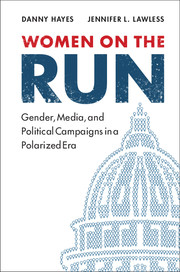Book contents
- Frontmatter
- Contents
- List of figures
- List of tables
- Acknowledgments
- 1 Gender, myth, and reality on the campaign trail
- 2 Rethinking and reassessing gender differences on the campaign trail
- 3 That's what she said, and so did he
- 4 Sex is no story
- 5 The party, not the person
- 6 The origins and implications of perceptions of gender bias
- Appendices
- Works cited
- Index
6 - The origins and implications of perceptions of gender bias
Published online by Cambridge University Press: 05 May 2016
- Frontmatter
- Contents
- List of figures
- List of tables
- Acknowledgments
- 1 Gender, myth, and reality on the campaign trail
- 2 Rethinking and reassessing gender differences on the campaign trail
- 3 That's what she said, and so did he
- 4 Sex is no story
- 5 The party, not the person
- 6 The origins and implications of perceptions of gender bias
- Appendices
- Works cited
- Index
Summary
Five chapters, 110 pages, and dozens of tables and figures ago, we laid out an argument that challenges the conventional wisdom about gender and political campaigns. Despite the view – widely held by the press, politicians, political scientists, and the public – that women who run for office face a systematically more challenging or fundamentally different political environment than men, we contended that two features of politics in the twenty-first century have helped level the playing field. The declining novelty of women in politics and the polarization of the Republican and Democratic parties have left little space for the sex of a candidate to influence modern campaigns. In U.S. House elections across the entire country, and likely in the thousands of down-ballot races that reflect similar conditions, women and men face similar electoral landscapes.
This argument naturally meets skepticism. Although we have known for decades that women win elections at the same rate as men, the sense in public discourse and much of the scholarly literature is that women achieve these victories in spite of a more onerous and inhospitable campaign trail. This is undoubtedly an understandable perspective. Women have had the right to vote for less than a hundred years, and the quest for women's representation has been long, bumpy, and difficult. It wasn't until 1978 that a woman who wasn't replacing her deceased husband was elected to the U.S. Senate. Not until 1993 did more than two women serve in the chamber simultaneously. And women continue to make up less than one-quarter of the elected officials in Congress, state capitols, and city halls. The campaign trail seems a logical culprit.
But when we consider the electoral environment's key components, there is reason to doubt that the campaign trail systematically differs for women and men. First, the main imperative for candidates – male and female alike – is to portray themselves as embodying the personal characteristics and prioritizing the issues that voters value. This creates commonality, not divergence, in men's and women's campaigns. In an era in which partisanship is the chief factor that differentiates opposing candidates, whether in television advertising or social media, campaigns will reflect a clash of the partisans, not a battle of the sexes. Second, because press coverage of campaigns strongly corresponds to candidate messages, reporters will cover men and women similarly.
- Type
- Chapter
- Information
- Women on the RunGender, Media, and Political Campaigns in a Polarized Era, pp. 111 - 136Publisher: Cambridge University PressPrint publication year: 2016



